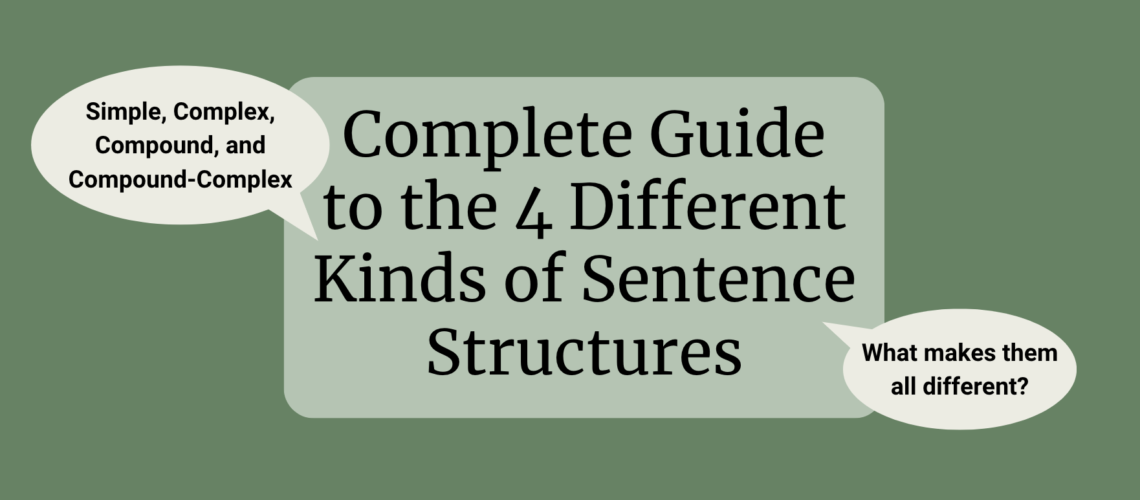Complete Guide to the 4 Different Kinds of Sentence Structures
October 11, 2024

There are four different sentence structures to choose from: simple, compound, complex, and compound-complex. Each has a different assortment of independent and dependent clauses, and using a variety of structures makes your writing more interesting to read!
Let’s start off with the easiest one to master: the simple sentence.
Simple Sentences
A simple sentence consists of one independent clause. That’s it. There are no other independent clauses and no dependent clauses at all.
According to Constance Hale (author of Sin & Syntax), a simple sentence is “a mini-narrative that contains one and only one subject-predicate pair.“

There might be many other words in a simple sentence—adjectives, adverbs, direct objects, additional verbs, etc.—but there is only one subject-verb pair.

Compound Sentences
A compound sentence has two or more independent clauses. These independent clauses are joined by either a comma plus a coordinating conjunction (one of the FANBOYS conjunctions) or by a semicolon.
Juliet’s cousin Tybalt wanted to kill Romeo for coming to the ball; Juliet’s father would not allow it.

As Hale notes, a compound sentence can bring separate ideas together in comparison or juxtaposition, but the independent clauses are inherently balanced; they are equal in weight and importance.
The independent clauses are called coordinating clauses.
Romeo snuck into the Capulet family’s orchard, and Juliet was looking over the orchard from her balcony.

Note that compound sentences do not contain any dependent clauses; if you have a dependent clause in your sentence, you’re getting into the world of complex or compound-complex sentences.
Complex Sentences
Complex sentences have one independent clause with one or more dependent clauses. Dependent clauses are made dependent by subordinating conjunctions; they still have a subject and a predicate, but they do not express a complete thought.
Learn more about dependent clauses here!
Friar Laurence marries Romeo and Juliet because he hopes that their love will end their families’ feud.

Hale states that “complex sentences allow us to express an idea with some interesting kinks in it. […] When we join two clauses with subordinate conjunctions like because, if, although, or since, we are putting ideas into a kind of hierarchy, subordinating one idea to another.”
If the sentence STARTS with the dependent clause, there is usually a comma after this clause (before the independent clause).
Since Romeo refuses to fight Tybalt, Mercutio challenges Tybalt instead.

Remember that a complex sentence could have any number of dependent clauses, but it will always have only ONE independent clause. If there is more than one independent clause (and one or more dependent clauses), you have a compound-complex sentence.
Compound-Complex Sentences
Compound-complex sentences have two or more independent clauses with one or more dependent clauses.
Since Juliet’s father said she must marry Paris, Juliet ran to Friar Laurence for help, and the Friar came up with a plan to help her escape.

The only difference between a complex sentence and a compound-complex sentence is the number of independent clauses: a complex sentence has just ONE independent clause, and a compound-complex sentence has two or more independent clauses.
Friar Laurence’s messenger did not reach Romeo in time, so although Juliet was only sleeping, Romeo believed she was dead.

If you have any questions about these four different kinds of sentence structures, leave them in the comments and I’ll find you an answer!
Learn all about independent and dependent clauses here!
Sources:
- The Chicago Manual of Style. 17th ed. Chicago, IL: The University of Chicago Press, 2017.
- Hale, Constance. Sin and Syntax: How To Craft Wicked Good Prose. New York: Three Rivers Press, 2013.
